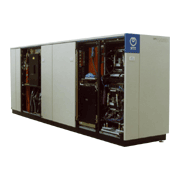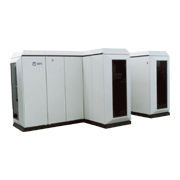In the second half of 1986, the NTT Research Laboratory began studying the development of successor machines for the DIPS-11/5E series, with the aim of maintaining the same cost-performance ratio as commercial machines while maintaining and extending user program assets. The 5EX Series inherited, as is, a composite configuration based on a 100-Mbit/s optic loop from the 5E Series and otherwise minimized extension of the architecture. Hardware development went forward based on the exploitation of manufacturing company technology.
Development started at the beginning of 1988, and development of the 5EX, 15EX, 25EX, and 45EX went forward with the goal of improving the performance of each model in the 5E Series by 1.5 to 2 times. Prototyping finished between 1990 and 1991 (DIPS-11/5EX Series Main Specifications).
The 5EX Series realized a serial transfer system that used an optic interface as the channel technology and thereby enabled transfer speeds of 18 MB/second and a maximum cable length of about 2 km. This greatly exceeded the previous electric signal-based performance, i.e., a maximum transfer speed of about 5 MB/second and a maximum cable length of 120 m.
An independent I/O interface extension unit was developed to increase the high-speed optic loop interface distance, thus enabling usage transcending distance limitations and making it possible for users to access an information processing center from a remote site located several tens of kilometers away.
With the trend toward downsizing and the move toward general-purpose computer procurement based on MIA/SPIRIT specifications, the DIPS joint research (begun in 1969 by NTT, NEC, Hitachi, and Fujitsu) finished in March 1992, with the completion of development of the 5EX Series.
CCPs (DIPS CCP-IEX, CCP-IIEX) for the DIPS-11/5EX Series were developed in parallel.
| Item | Model 5EX | Model 15EX | Model 25EX | Model 45EX | (Reference) DIPS-1 | ||
|---|---|---|---|---|---|---|---|
| Performance (DIPS-11/10 ratio) | 9 | 14 | 32 | 30 | 0.7 | ||
| System | Number of CPUs | 2 | 4 | 4 | |||
| Maximum memory capacity (MB) | 512 | 1024 | 16 | ||||
| Total number of channels | 32 | 64 | 256 | 128 | 16 | ||
| Processing unit (CPU) |
Number of instructions | 220 | 160 | ||||
| Local memory capacity (KB) | 64 | 256 | 128 | 8/16 | |||
| Buffer memory capacity (KB) | 512 | 1024 | — | — | — | ||
| Main logic element (gate/chip) | 2K ECL LSI | 12K ECL LSI | 12K ECL LSI | 15K ECL LSI | ECL SSI‚MSI | ||
| Memory unit (MEM) |
Control unit (MB) | 32 | 64 | 1 | |||
| Expansion unit (MB) | 32 | 512 | 128 | 1 | |||
| Memory element (b/chip) | 4M DRAM | 1M SRAM | Magnetic core | ||||
| Transfer unit (DCH) |
Channel types | 6 types | 12 types | 4 types | |||
| Maximum throughput (MB/S) | 96 | 283 | 400 | 768 | 12 | ||




